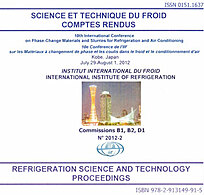
IIR document
A new defrosting method for utilization of frost.
Number: pap. O34
Author(s) : INOUE S., OHKUBO H., IKEMOTO S.
Summary
When a solid surface is cooled below the solidification temperature of water, vapor condenses on the solid surface forming frost. The frost formation is a transient phenomenon where heat and mass transfer take place simultaneously. Frost formation can often lead to a deterioration of the performance of consumer products such as refrigerators and heat pumps. Generally, defrosting is carried out by melting the frost on the heat exchangers of the devices periodically. Here, the authors propose a new mechanical method in which the heat exchangers can still maintain their low temperatures while defrosting. Therefore, not only that the overall efficiency of the heat exchangers can be improved, but also the frost crystals removed can be utilized as a regenerative material. Frost formation process consists of two stages: the crystallization of frost and growth of the frost layer, which depend on environmental and surface-related factors. In this study, the authors investigated the effect of the cooling surface characteristics on the amount of frost formed and frost layer thickness. To evaluate the frosting process, they used in this experimental investigation a new parameter, which is the force required scrap off the frost from the cooling surface. In addition, they investigated the recyclability of the frost crystals removed, as ice.
Available documents
Format PDF
Pages: 8 p.
Available
Public price
20 €
Member price*
Free
* Best rate depending on membership category (see the detailed benefits of individual and corporate memberships).
Details
- Original title: A new defrosting method for utilization of frost.
- Record ID : 30004997
- Languages: English
- Source: 10th International Conference on Phase-Change Materials and Slurries for Refrigeration and Air Conditioning. Proceedings: Kobe, Japan, July 29-August 1, 2012.
- Publication date: 2012/07/01
Links
- See translations: Un método nuevo de descongelación para la utilización de la escarcha.
See other articles from the proceedings (46)
See the conference proceedings
Indexing
-
Themes:
Heat transfer;
Mass transfer;
Defrosting systems - Keywords: Frosting; Frost; Mass transfer; Heat transfer; Expérimentation; Defrosting; Heat exchanger
-
Heat and mass transfer in the defrost process: ...
- Author(s) : MOHS W. F., KULACKI F. A.
- Date : 2011/08/21
- Languages : English
- Source: Proceedings of the 23rd IIR International Congress of Refrigeration: Prague, Czech Republic, August 21-26, 2011. Overarching theme: Refrigeration for Sustainable Development.
- Formats : PDF
View record
-
Frost properties on cold surface simple geometr...
- Author(s) : LEE Y. S., YOON S. H., HAYASE G., et al.
- Date : 2010/06/07
- Languages : English
- Source: ACRA2010. Asian conference on refrigeration and air conditioning: Tokyo, Japan, June 7-9, 2010.
- Formats : PDF
View record
-
Heat transfer with frosting phenomena under nat...
- Author(s) : YOSHIOKA R., INOUE S., OHKUBO H.
- Date : 2010/06/07
- Languages : English
- Source: ACRA2010. Asian conference on refrigeration and air conditioning: Tokyo, Japan, June 7-9, 2010.
- Formats : PDF
View record
-
Study on mass transfer with frosting phenomenon...
- Author(s) : INOUE S., OHKUBO H.
- Date : 2010/06/07
- Languages : English
- Source: ACRA2010. Asian conference on refrigeration and air conditioning: Tokyo, Japan, June 7-9, 2010.
- Formats : PDF
View record
-
Frost characteristics and heat and mass transfe...
- Author(s) : KWAK D. K., KIM S., CHO K.
- Date : 2012/06/25
- Languages : English
- Source: 10th IIR-Gustav Lorentzen Conference on Natural Working Fluids (GL2012). Proceedings. Delft, The Netherlands, June 25-27, 2012.
- Formats : PDF
View record
